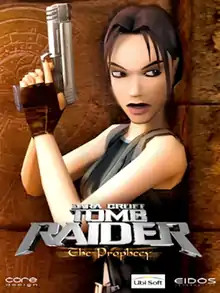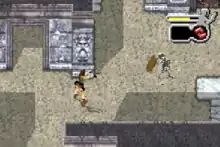Tomb Raider: The Prophecy
Tomb Raider: The Prophecy is an action-adventure video game released in November 2002 for the Game Boy Advance, part of the Tomb Raider franchise. It was developed by Ubisoft Milan, and published by Ubisoft under license from Eidos Interactive.
| Tomb Raider: The Prophecy | |
|---|---|
 | |
| Developer(s) | Ubisoft Milan |
| Publisher(s) | Ubisoft |
| Series | Tomb Raider |
| Platform(s) | Game Boy Advance |
| Release | |
| Genre(s) | Action-adventure |
| Mode(s) | Single-player |
Gameplay

Unlike previous handhelds in the series such as the Tomb Raider: Curse of the Sword, which played in a side-scrolling two-dimensional form, reminiscent of 8-bit games, The Prophecy instead plays in an isometric viewpoint, giving the player a viewpoint from above the player character's head.[1] The game contains many familiar elements of the franchise such as being able to jump, run, climb and shoot. As the game was the first Tomb Raider to be rendered in an isometric view until Lara Croft and the Guardian of Light, the game was also given a new combat system to suit the view style. The system does not include the regular player-controlled lock on gun play of previous games. It does instead contain an auto-lock system to make combating enemies easier. There are three weapons that the player can use: Lara's signature handguns, Uzi pistols and golden guns. The controls were designed to be simple, with the directional pad assigned to movement, the A button is used as a jump button, the R button pulls out or holsters weapons, and the L button allows the player to sprint.
Plot
The game is based around an ancient prophecy written in the Tome of Ezekiel, which tells of three magical stones, used by various powerful rulers around the world. Lara Croft must find these stones before a cult known as the Teg-du-Bhorez can collect them all and use them to revive a mystical being known as the Great Grey One, thus bringing about the end of the world. Throughout the game Lara searches for the stones and thinks that she has found them. However, she realises that she was mistaken and has to come back to defeat the game's villain.
Reception
| Aggregator | Score |
|---|---|
| Metacritic | 66/100[2] |
| Publication | Score |
|---|---|
| Eurogamer | 6/10[3] |
| GameSpy | |
| GameZone | 7/10[5] |
Tomb Raider: The Prophecy received "mixed or average" reviews, according to review aggregator Metacritic.[2]
The game received a 3 1⁄2-out-of-5 score from GameSpy reviewer Scott Steinberg, who praised it for the aesthetic effects of the game camera, which give the illusion that the player can see into a 3-dimensional space. However, Steinberg criticized the repetitive nature of the game, as it largely consists of the player having to "Trigger a switch, and you open a door or shut off a trap. Then it's off to the next switch, next door, and so on and so forth." [4] GameSpy concluded that although the game has some merits, it falls short in terms of gameplay standards of many of its greatest assets are related to audio and visuals.
The Prophecy was a runner-up for GameSpot's annual "Best Action Game on Game Boy Advance" award, which went to Metroid Fusion.[6]
References
- "Tomb Raider: The Prophecy". IGN. 13 August 2002. Retrieved 8 November 2012.
- "Tomb Raider: The Prophecy for Game Boy Advance". Metacritic. Retrieved 1 August 2011.
- "Tomb Raider: The Prophecy Review". Eurogamer. 3 December 2002. Retrieved 8 November 2012.
- "Tomb Raider: The Prophecy". Gamespy. 12 November 2002. Archived from the original on 3 January 2013. Retrieved 8 November 2012.
- "Lara Croft Tomb Raider: The Prophecy-GBA-Review". Gamezone. 1 December 2002. Retrieved 8 November 2012.
- GameSpot Staff (30 December 2002). "GameSpot's Best and Worst of 2002". GameSpot. Archived from the original on 7 February 2003.